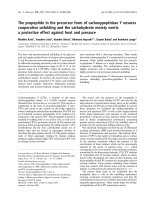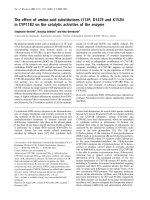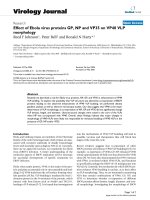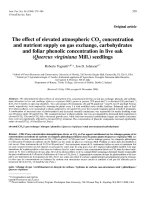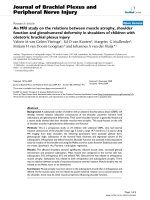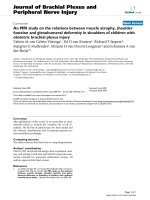Effect of ketofol versus propofol as an induction agent on ease of laryngeal mask airway insertion conditions and hemodynamic stability in children a prospective cohort study
Bạn đang xem bản rút gọn của tài liệu. Xem và tải ngay bản đầy đủ của tài liệu tại đây (942.75 KB, 50 trang )
ADDIS ABABA UNIVERSITY
COLLEGE OF HEALTH SCIENCES
SCHOOL OF GRADUATE STUDIES DEPARTMENT OF ANESTHESIA
Effect of Ketofol versus propofol as an induction agent on ease of laryngeal mask
airway insertion conditions and hemodynamic stability in children: A Prospective
cohort study
Investigator: Bacha Aberra (Msc Anesthesia candidate)
Advisor: Adugna Aregawi
Research thesis prepared for partial fulfillment of the requirements for the masters
of sciences degree in Advanced Clinical Anesthesia.
June, 2017,
Addis Ababa, Ethiopia
I
Addis Ababa University College of Health Sciences, School Of Graduate Studies,
Department Of Anesthesia
Effect of Ketofol versus propofol as an induction agent on ease of laryngeal mask
airway insertion conditions and hemodynamic stability in children, Addis Ababa,
Ethiopia, 2017: A Prospective Cohort Study
By: Bacha Aberra (Bsc)
Advisor: Adugna Aragawi (BSc, MSc)
Signature___________
Research thesis prepared for partial fulfillment of the requirements for the masters
of sciences degree in Advanced Clinical Anesthesia.
June, 2017
Addis Ababa, Ethiopia
I
CERTIFICATION
The undersigned certify that the research entitled Effect of Ketofol versus propofol as an
induction agent on laryngeal mask airway insertion conditions and hemodynamic stability in
children, Addis Ababa, Ethiopia, 2017: A Prospective Cohort Study is my original work and any
literature and/or data cited in this article were listed in the reference section and any assist done
during this period has been given an acknowledgement.
Author
Name ________________________ Signature ______________ Date ______________
Approval of the Board of Examiners
1. Advisor
Name ________________________ Signature ______________ Date ______________
2. Internal Examiner
Name _________________________ Signature ______________ Date ______________
3. External Examiner
Name __________________________ Signature ______________ Date ______________
II
ACKNOWLEDGEMENT
I would like to express my deepest appreciation and gratitude to my advisor Mr. Adugna
Aregawi for his constant motivation, support, scientific inputs and guidance. I would also extend
my appreciation to department of Anesthesia, Addis Ababa University for providing necessary
supports. My special thanks also go to administrators of Menelik II Hospital, anesthesia
department of the Hospital, for providing us useful information. Lastly, but not least, I would
like to appreciate the data collectors for their help and for the time they gave.
III
Acronyms and Abbreviations
ASA: American Society of Anesthesiologists
BMA: Bone marrow aspiration
BIS: Bispectral index
DBP: Diastolic blood pressure
ECG: Electrocardiography
GA: General anesthesia
GABA: Gamma amino butyric acid
IRB: Institutional review board
KP: Ketofol
LMA: Laryngeal mask airway
LP: Lumbar puncture
LTS II: Laryngeal tube suction II
MAP: Mean arterial blood pressure
NMDA: N-Methyl-D-Aspartate
PLMA: Proseal Laryngeal mask airway
PSA: Procedural sedation
SBP: Systolic blood pressure
SpO2: Arterial oxygen saturation
SPSS: Statistical Package for social sciences
IV
List of tables and figures
List of tables
Table1: Socio-demographic features of the patients at Menelik II Hospitals, Addis Ababa,
Ethiopia, from Jan 25-March, 25, 2017.….…………………………………………………….18
Table2: Requirement of Additional propofol, duration of apnea and attempts of LMA insertion at
Menelik II Hospitals, Addis Ababa, Ethiopia, from Jan 25-March, 25, 2017.…………………19
Table3: Comparison of Insertion Conditions of LMA between the ketofol and propofol groups at
Menelik II Hospitals, Addis Ababa, Ethiopia, from Jan 25 -March, 25, 2017.…………………20
Table4: Comparing the Mean of data on mean arterial blood pressure between ketofol and
propofol at Menelik II Hospitals, Addis Ababa, Ethiopia, from Jan 25-March, 25,
2017.……………………………………………………………………………………………22
Table5: Comparing the Mean of data on heart rate between ketofol and propofol at Menelik II
Hospitals, Addis Ababa, Ethiopia, from Jan 25-March, 25, 2017.……………………………24
List of figures
Figure 1: Conceptual frame work of the study …………………………………………………9
Figure 2: Flow of the study subjects……………………………………………………………14
Figure 3: Changes in mean arterial pressure between ketofol and propofol group ……………23
Figure 4: Changes in heart rate between ketofol and propofol group………………………….25
V
Table of Contents
ACKNOWLEDGEMENT ........................................................................................................................... III
Acronyms and Abbreviations ....................................................................................................................... IV
List of tables and figures ............................................................................................................................... V
ABSTRACT............................................................................................................................................... VIII
CHAPTER ONE: INTRODUCTION ........................................................................................................... 1
1.1 Background ......................................................................................................................................... 1
1.2 Statement of the problem .................................................................................................................... 3
1.3 Justification of the study ..................................................................................................................... 4
CHAPTER TWO: LITERATURE REVIEW ............................................................................................... 5
2.1 Conceptual frame work ....................................................................................................................... 9
CHAPTER THREE: OBJECTIVES ........................................................................................................... 10
3.1 General Objective ............................................................................................................................. 10
3.2 Specific Objectives ........................................................................................................................... 10
CHAPTER FOUR: METHODS AND MATERIALS ................................................................................ 11
4.1 Study area and period........................................................................................................................ 11
4.2 Study design ...................................................................................................................................... 11
4.3 populations ........................................................................................................................................ 11
4.3.1 Source population ...................................................................................................................... 11
4.3.2 Study population ........................................................................................................................ 11
4.4 Eligibility criteria .............................................................................................................................. 11
4.4.1 Inclusion criteria ........................................................................................................................ 11
4.4.2 Exclusion criteria ....................................................................................................................... 11
4.5 Study Variables ................................................................................................................................. 12
4.5.1 Dependent variables .................................................................................................................. 12
4.5.2
Independent variables ......................................................................................................... 12
4.6 Operational Definitions ..................................................................................................................... 12
4.7 Sample size and sampling techniques determination ........................................................................ 13
4.7.1 Sample size ................................................................................................................................. 13
4.7.2 Sampling Technique ................................................................................................................... 13
4.8 Implementation of observation and measurement variable............................................................... 15
VI
4.9 Data collection technique and instrument ......................................................................................... 16
4.10 Data quality assurance .................................................................................................................... 16
4.11 Data processing and analysis .......................................................................................................... 17
4.12 Ethical Consideration ...................................................................................................................... 17
4.13 Presentation and dissemination plan ............................................................................................... 17
CHAPTER FIVE: RESULTS ..................................................................................................................... 18
5.1: Socio-demographic features and operative conditions .................................................................... 18
5.2: Comparison of ease of insertions conditions ................................................................................... 19
5.3: Comparison of hemodynamic characteristics .................................................................................. 21
CHAPTER SIX: DISCUSSION ................................................................................................................. 26
Strength and Limitations of the study ..................................................................................................... 28
CHAPTER SEVEN: CONCLUSION AND RECOMMENDATIONS ..................................................... 29
7.1 Conclusion ........................................................................................................................................ 29
7.2: Recommendations ............................................................................................................................ 29
REFERENCES ....................................................................................................................................... 30
Annex II: Information Sheet ................................................................................................................... 35
Annex III: English Version Consent Form ............................................................................................. 37
Annex IV: Amharic Version Consent Form .............................................................................................. 38
Annex V: Questionnaires ........................................................................................................................ 39
VII
ABSTRACT
Background: Laryngeal mask airway is a simple supraglottic device which has led to a radical
change in the management of modern general anaesthesia. In the present study, we evaluated the
laryngeal mask airway insertion conditions and hemodynamic changes comparing ketaminepropofol mixture (ketofol) with propofol.
Objective: The objective of this study was to compare ketamine–propofol mixture (ketofol)
with propofol on the ease of laryngeal mask airway insertion conditions for induction of general
anaesthesia (GA).The hemodynamic effects were also looked at.
Materials and Methods: In this prospective cohort study120 pediatric patients age 2 – 15 years
undergoing general anesthesia with LMA for elective ophthalmic surgeries at Menelik II
Hospital from Jan 25 -March, 25, 2017 were included. A six variable (mouth opening, ease of
insertion, swallowing, coughing, movement and laryngospasm) three-point score was used to
assess insertion conditions. LMA insertion summed score was prepared depending upon these
variables. Hemodynamic variables Heart rate and mean arterial pressure were noted 1 min before
induction (baseline), immediately after induction, immediately after insertion of LMA and 1,2
and 3 minute after LMA insertion. Insertion conditions were compared using Chi-square test
while hemodynamic variables were compared using independent t test.
Results: LMA insertion summed score was nearly similar between the two groups. Mean blood
pressure and heart rate were maintained higher in ketofol group while significant drop were
observed in propofol group. The time from the LMA placement to the return of spontaneous
ventilation was significantly longer in propofol group (240 seconds [range =60– 360 seconds])
compared with ketofol group (180 seconds [range= 30–320 seconds]) (p= 0.005).
Conclusion and Recommendations: LMA insertion condition summed score was comparable
in both ketofol and propofol group. Ketofol provided equivalent LMA insertion conditions while
maximizing hemodynamics and minimizing apnea time. When parameters such as LMA
insertion conditions and hemodynamic stability are considered, ketofol can be used as an
alternative
to
propofol
for
LMA
insertion
in
pediatrics.
VIII
CHAPTER ONE: INTRODUCTION
1.1 Background
The major responsibility of an anesthetist is management of airway so as to provide adequate
ventilation to the patient by securing airway when general anesthesia is administered. As such,
no anesthesia is safe unless diligent efforts are devoted to maintain an intact functional airway (1,
2). Laryngeal Mask Airway (LMA) is a simple supraglottic device which is placed without
requiring direct laryngoscopy either in adults or in children. In many cases, possibility of
intubation or mask ventilation is poor; using LMA to control airway and make an adequate
airway is effective in 94% of cases in patients (3). Several methods have been introduced for
LMA insertion while no standard anesthesia induction method has been proposed to guarantee a
proper placement of the device (4, 5).
LMA is a very safe device with the least complications (6). The most frequent anesthetic used
for LMA placement is propofol (7, 8). Intravenous propofol can be successfully used as a sole
induction agent to facilitate laryngeal mask airway (LMA) insertion even in children because of
its predominant upper airway reflexes depressant action (9).
When administered alone for LMA insertion, propofol could be associated with undesirable
complications including coughing, gag reflex, laryngospasm, and inability to provide analgesia
which prevents it from being the sole anesthetic medication for any stimulating procedures (10,
11)
Numerous pharmacological agents and combinations have been introduced to decrease the
hemodynamic instability throughout anesthesia (12, 13).
Ketamine is well-known for its airway reflexes maintaining activity and sympathetic stimulation
so as to causes little or no cardio‑respiratory depression and unlike propofol has pain relieving
properties. It is unique in that it is a cardiovascular and respiratory stimulant. These are desirable
in pediatric anesthesia (14, 15).
1
Ketamine in subanaesthetic doses with propofol has gained attention in total intravenous
anaesthetic technique because of its powerful analgesic action without causing myocardial or
respiratory depression (16-18)
“Ketofol” is a moniker for ketamine and propofol administered either independently or as a
single-syringe admixture. Ketofol has been advocated as the ideal PSA combination because the
need for lower doses of each agent combined with the opposing actions of both agents
theoretically decreases the incidence of dose-related side effects (11). Effectiveness of the two
agents – propofol and ketamine – in combination (ketofol) has been recently demonstrated and
may provide a novel induction agent with favorable hemodynamics and reduced side effects
attributed to either drug (19). By combining propofol and ketamine, there is additive effect of
GABA agonism by propofol and NMDA antagonism by ketamine leading to lesser doses of
propofol required along with ketamine (20). In addition, addition of analgesic doses of ketamine
to propofol lowers the dose of propofol, provides better intubating conditions and overcomes the
risk of adverse effects (21).
2
1.2 Statement of the problem
LMA insertion has been revolutionized with the development of induction agents like propofol
which depresses pharyngeal and laryngeal reflexes (22).
Successful insertion of the LMA requires optimum anaesthetic depth to avoid unwanted airway
reflexes such as swallowing, gagging, coughing or involuntary movements to severe
complications such as laryngospasm (23, 24).
Satisfactory anesthetic induction conditions are best provided by propofol compared to other
intravenous induction agents (23). However, when propofol is used as a single induction agent in
unpremedicated patients, doses exceeding 3 mg/kg is required to allow smooth and atraumatic
LMA insertion (3, 25). Elevated propofol doses are not desirable as the cardiorespiratory
depression is dose dependent (22,26). Study shows up to 31.72% decrement in mean arterial
pressure immediately after induction when anesthesia is induced with propofol alone). Therefore
propofol as a single agent is unsatisfactory and to overcome problems associated with it, a
number of other co-induction drugs have been introduced (27).
Ketamine, an N-methyl d-aspartate (NMDA) receptor antagonist, has beneficial airwaymaintaining and sympathomimetic effects when used as a co-induction agent at sub-anesthetic
doses (28, 29).
In our country some centers use the combination of ketamine and propofol as co-induction agent
during LMA insertion, while its effect on LMA insertion condition and hemodynamic changes is
not well studied. As to the knowledge of the investigators, there is also limited literature
available on ketamine and propofol combination for LMA insertion. Therefore this study is
aimed to compare the effect of ketamine–propofol mixture (ketofol) and propofol on the
insertion conditions of LMA and hemodynamics pediatrics.
3
1.3 Justification of the study
Sufficient deepness of anesthesia and mouth openness is needed for correct insertion of
supraglottic airway devices and prevents such complications as coughing, swallowing, head and
extremity movements and laryngospasm. When propofol used alone it cannot provide LMA
insertion conditions or high dose of propofol is needed to improve the insertion conditions. On
the other hand, high dose of propofol cause cardiorespiratory depression. Ketamine increases
heart rate and arterial blood pressure by virtue of increased centrally mediated sympathetic tone
and increased centrally mediated release of catecholamines from the adrenal medulla. Clinical
effects of propofol and ketamine seem to be complementary.
Therefore the finding of this research will help:
Anesthesia professionals
To provide Safe and effective alternative induction agent for better LMA insertion
conditions and improved hemodynamic stability.
To enhance evidence based practice.
Health administrators
To work on quality improvement to enhance good patient outcome.
To supply cost effective anesthetic drugs with better patient outcome to enhance income
generation and cost reduction.
Researchers
Used as a footstep for next studies to be done on similar problems.
4
CHAPTER TWO: LITERATURE REVIEW
In study conducted to compare the effects of ketamine and alfentanil administered prior to
induction of anesthesia with propofol, on the hemodynamic changes and ProSeal laryngeal mask
airway (PLMA) insertion conditions, 80 children, aged between 3–132 months, were randomly
allocated to receive either alfentanil 20 µg/kg or ketamine 0.5 mg/kg before induction of
anesthesia. They found that the administration of ketamine 0.5 mg/kg with propofol 4 mg/kg
preserved hemodynamic stability, and reduced the time to the return of spontaneous ventilation,
compared with alfentanil 20 µg/kg during PLMA placement. In addition, the conditions for
insertion of the PLMA with ketamine were similar to those found with alfentanil (30).
In a study conducted on 120 pediatric patients of ASA Grade I and II of either sex aged 3-12
years scheduled for pediatric surgeries under general anaesthesia showed that increasing dose of
propofol decreases the adverse events like inadequate jaw relaxation, limb movements,
coughing, gagging and laryngospasm. Midazolam when added to propofol further reduces the
incidence of adverse events and provides more favorable environment for insertion of LMA. At
higher doses of propofol (5 mg kg-1), hypotension is a major problem due to its cardiovascular
depressant action. Therefore, 4 mg kg-1 propofol along with midazolam is the optimum dose
because there is more hemodynamic stability to get better conditions for LMA insertion (31).
Randomized double blind comparison of ketamine-propofol and fentanyl–propofol for the
insertion of laryngeal mask airway was done in children of age 3-13 years. Hundred ASA I and
II patients were randomly allocated to receive intravenously either fentanyl 2µg/kg (group
F,n=50) or ketamine 0.5 µg/kg (group K, n=50) before induction of anesthesia with propofol 3.5
µg/kg. Coughing/gagging was seen in 8% patients in group F as compared to 28% patients in
group K. Limb /head movements were observed in 64% patients in the fentanyl group and in
76% patients in the ketamine group. Laryngospasm was not seen in any patient in either group.
Incidence of apnea was 80% in the fentanyl group and 50% in the ketamine group. The heart
rate, SBP, DBP and MAP were consistently higher in the ketamine group as compared to the
fentanyl group. The combination of fentanyl and propofol provides better conditions for LMA
insertion in children than a combination of ketamine and propofol (32).
In a clinical comparison of ketofol (ketamine and propofol admixture) versus propofol as an
induction agent on quality of laryngeal mask airway insertion and hemodynamic stability in
5
children, Yousef and Elsayed showed that Ketofol is a safe and effective alternative induction
agent for LMA insertion in children with rapid onset of action and lower incidence of injection
pain. It provided better LMA insertion conditions, improved hemodynamic stability with less
prolonged apnea when compared to propofol (15).
A prospective randomized double blinded study was done to compare ease of inserting LMA and
the hemodynamic effects of etomidate with propofol for induction of general anaesthesia (GA)
with LMA. Patients were induced with intravenous (I/V) fentanyl and induction agent either
etomidate or propofol according to group randomization. LMA was inserted after 30 seconds.
Intra-operative heart rate (HR), systolic blood pressure (SBP), diastolic blood pressure (DBP),
mean arterial pressure (MAP), number of attempts and duration of LMA insertion were
monitored. There was no difference in the heart rate between the two groups. A significant drop
was found for systolic blood pressure (SBP) in propofol group while diastolic blood pressure
(DBP) was decreased in both the groups. In propofol group, successful insertion of LMA was
achieved on the first attempt in 93.3% of patient as compared to 36.7% in etomidate group (33).
In another randomized double blind prospective study which included 90 ASA I & II patients
aged between 15 and 50 years scheduled for ambulatory urological; ambulatory
urogynaecological procedures, they concluded that among the two admixtures propofol ketamine
has an edge over propofol-thiopentone because of its better hemodynamic stability and superior
airway maintenance (34).
In a randomized double blind prospective study which included 100 children scheduled for LMA
insertion the effects of ketofol and propofol were compared and concluded that ketofol is a safe
and effective alternative induction agent for LMA insertion in children with rapid onset of action
and lower incidence of injection pain. It provided better LMA insertion conditions, improved
hemodynamic stability with less prolonged apnoea when compared with propofol (35).
In a randomized double blind prospective study which included 80 ASA I & II patients posted
for laryngeal tube suctioning compared the effects of propofol and ketofol and concluded that
ketofol provided better insertion summed score for LTS II than propofol with minimal
haemodynamic changes (35, 36).
6
Prospective, randomised and double blind study was done to compare the effects of ketamine
and midazolam as a co-induction agents with propofol for PLMA insertion. The ketaminepropofol group had significantly better mouth opening) and shorter duration of apnoea. Other
conditions during PLMA insertion and the overall grading were comparable between groups.
Haemodynamic parameters were comparable to baseline within each group. However, the
ketamine-propofol group had more stable blood pressure readings and maintained a higher heart
rate compared to the midazolam- propofol group (37).
A randomized double-blind study, in which 90 total patients having a laryngeal mask airway
(LMA) placed received propofol (2.5 mg/kg) with either ketamine (0.5 mg/kg), fentanyl (1
ug/kg), or placebo normal saline (38) When measured vital signs and pre-determined time points
and ease of LMA insertion, they found the ketofol group had a significantly higher systolic blood
pressure than the other two groups and the incidence of prolonged apnea (>120 s) was higher in
the fentanyl group (23.1%) than in either the ketofol group (6.3%) or the normal saline group
(3.3%). They concluded that ketofol provided equivalent LMA insertion conditions while
maximizing hemodynamics and minimizing apnea (39).
In another randomized double blind prospective study which included 68 ASA I & II patients
undergoing elective general, orthopedic and gynecological procedures concluded that induction
dose of propofol is reduced considerably by prior administration of small dose of ketamine
compared to placebo using loss of verbal contact as end point of induction. Ketamine had the
advantage of better hemodynamic stability (40).
In the 10 trials comparing the combination of ketamine and propofol with either agent alone for
procedural sedation in the emergency department were examined. The evidence reviewed
suggests that combining these agents may help to minimize adverse effects such as hypotension
and respiratory depression. Ketamine is not commonly used as a single agent in adults because of
the risk for emergence reactions; however, when combined with propofol, no significant increase
in this adverse effect was found compared with propofol monotherapy (41).
In a randomized double blind prospective study which included 100 children, of age 3–14 years,
American Society of Anesthesiologist physical status IE-IIE, posted for emergency short surgical
procedures concluded that The combination of low-dose ketamine and propofol is more effective
7
and a safer sedoanalgesia regimen than the propofol–fentanyl combination in pediatric
emergency short surgical procedures in terms of hemodynamic stability and lesser incidence of
apnoea (42).
The study was done to compare the efficacy, respiratory and hemodynamic profiles, and side
effects of two various combinations of ketamine and propofol in patients undergoing bone
marrow aspiration (BMA) and lumbar puncture (LP). Patients received a slow bolus injection of
a solution containing combination of equal amount of propofol and ketamine (1:1) (Group I) or
two parts of propofol plus one part of ketamine (2:1) (Group II). Vital signs, oxygen saturation
(SpO2) and incidence of any side effects were recorded. In this study there was an increase
postoperative nausea, psychomimetic side effects, and increase recovery time with the largest
ketamine dosage (Group I) (43).
A clinical trial comparing thiopentone with ketamine as adjuncts to propofol was conducted on
60 women, aged 18-50 years, American Society of Anesthesiologists (ASA) physical status 1
and 2, undergoing day- care gynecological surgeries. Both the propofol-thiopentone and
propofol-ketamine admixtures provided adequate anesthesia. Propofol-ketamine proved superior
to propofol-thiopentone in terms of hemodynamic stability and requirement of a lesser total dose
of propofol. However, the patients in the propofol-thiopentone group had faster recovery (44).
A total of 120 American Society of Anesthesiologist physical status I and II patients 20–60 years
of age were randomly allocated into one of four groups. The K0 group received only 2 mg/kg
propofol. The K0.15 group received 0.15 mg/kg ketamine and 1.85 mg/kg propofol. The K0.3
group received 0.3 mg/kg ketamine and 1.7 mg/kg propofol. The K0.6 group received 0.6 mg/kg
ketamine and 1.4 mg/kg propofol. Endotracheal intubation was performed after muscle
relaxation. Systolic blood pressure (SBP), diastolic blood pressure (DBP), mean blood pressure
(MBP), heart rate (HR) and the bispectral index value were recorded. No significant differences
were observed in SBP, DBP, MBP, or HR among the groups after endotracheal intubation.
However, the number of patients with a decrease of MBP > 20% from baseline after induction
was significantly lower in the K0.6 group compared to that in the K0 group (P < 0.05).The
results suggest that ketofol with 0.6 mg/kg ketamine and 1.4 mg/kg propofol can be used as an
alternative to 2 mg/kg propofol (45).
8
Having adequate information about both ketofol and propofol on hemodynamic changes and
LMA insertion conditions in anesthesia practice in order to provide better anesthesia service to
improve anesthesia management and result in a better health service delivery.
2.1 Conceptual frame work
Ketofol
Weight
ASA status
Insertion conditions
Hemodynamic changes
Additional propofol
Attempts of LMA insertion
Mallampati class
Propofol
group
Figure 1: Conceptual frame work of the study
9
CHAPTER THREE: OBJECTIVES
3.1 General Objective
The aim of this study was to compare the effect of ketamine–propofol mixture (ketofol) and
propofol on the insertion conditions of laryngeal mask airway and hemodynamic stability in
children from Jan 25-March, 25, 2017.
3.2 Specific Objectives
To compare the effect of ketofol and propofol on the insertion conditions of laryngeal mask
airway
To compare the effect of ketofol and propofol on hemodynamics stability
10
CHAPTER FOUR: METHODS AND MATERIALS
4.1 Study area and period
This study was conducted at Menelik-II Hospital. Menelik II hospital is one of largest hospital in
the country. Menelik-II Hospital is now the main health provider center that offers high quality
comprehensive health services to patient from all over the region of Ethiopia and there are two
main operation departments, from which ophthalmic operation room has six operation tables.
One of these is pediatric OR table which on average, 1920 pediatric patients operated under
general anesthesia per year. The study was conducted from Jan 25-March, 25, 2017.
4.2 Study design
A prospective cohort study was employed from Jan 25-March, 25, 2017.
4.3 populations
4.3.1 Source population
All above 2 years old pediatric patients who underwent ophthalmic surgical operation under
general anesthesia with LMA in Menelik-II Hospital
4.3.2 Study population
All above 2 years old pediatric patients who underwent ophthalmic surgical operation under
general anesthesia with LMA in Menelik-II Hospital during the study period
4.4 Eligibility criteria
4.4.1 Inclusion criteria
Patients of ASA class I and II, age ranging from 2-15 years and undergoing elective surgical
procedures under GA using LMA was included in the study
4.4.2 Exclusion criteria
Patients with hyper-reactive airway disease
Patients with anticipated difficult airway
Patients on regular sedatives
Patients on β-blockers
11
